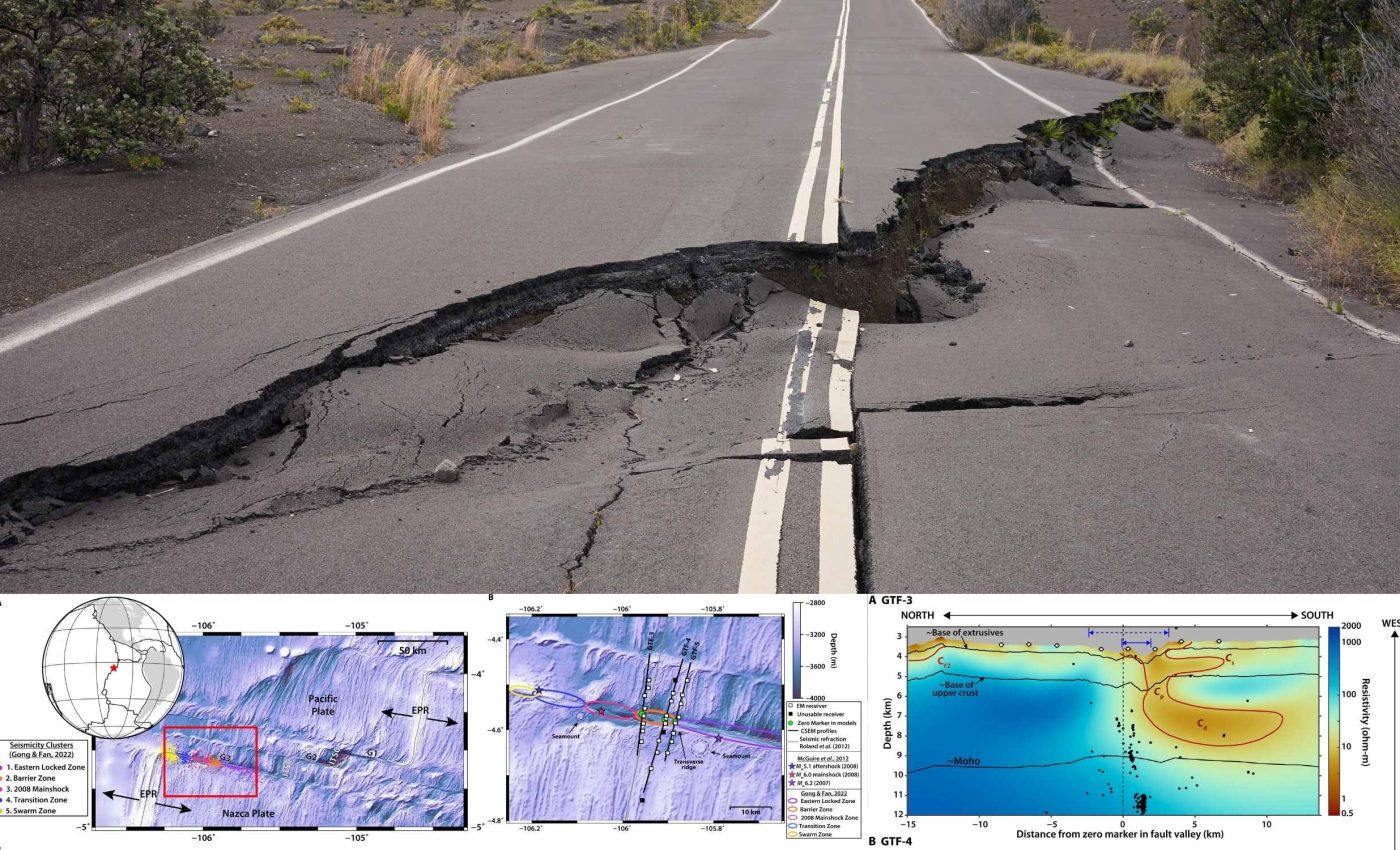
Scientists detect rare underwater salt deposits, possibly solving an earthquake mystery
Nearly three miles beneath the eastern Pacific, researchers found pockets of super-salty water trapped in the crust along the Gofar transform fault, one of the planet’s most active undersea plate boundaries. The find promises fresh insight into why this fault delivers magnitude‑6 earthquakes with clock‑like discipline.
The survey, led by Christine Chesley of Woods Hole Oceanographic Institution (WHOI), used controlled‑source electromagnetic (CSEM) instruments to map how easily electricity moves through the rocks, a trick that exposes hidden fluids better than standard seismic imaging.
Chesley’s team saw bright conductive blobs only on the Nazca Plate side of the fault, hinting at a one‑sided heat engine below.
Why transform faults matter
Unlike familiar subduction zones where one plate dives or mid‑ocean ridges where plates split, a transform fault lets plates slide past each other sideways, often producing shallow quakes.
Because these faults slice across spreading centers, they form a global zig‑zag seam on the seafloor. USGS
Gofar is exceptional because its segments race by at about 140 millimeters per year, among the fastest on Earth. That speed shortens the stress‑loading cycle so scientists can watch several full earthquake rounds during a single research career.
Instrument records show magnitude‑6 events striking Gofar every three to five years, a regularity rarely seen in tectonics. The new brine discovery offers a missing piece to that tidy schedule.
The San Andreas in California is the archetype on land, yet its slip rate of 35 millimeters per year is a quarter of Gofar’s, underscoring how quickly energy accumulates offshore.
Fast offshore faults therefore serve as natural laboratories for testing earthquake theories in compressed time.
Electric clues beneath the seabed
CSEM works by towing an energized dipole behind a ship and measuring how its signal diffuses through the crust; saltwater streaks light up because salt ions carry current far better than basalt or peridotite.
Seafloor receivers record the returning fields, and computer inversion turns those data into a resistivity map.
Before the cruise, models suggested a modest conductivity contrast near the fault plane caused by scattered seawater in cracks. Instead, data revealed zones thousands of feet across with conductivities orders of magnitude higher than expected.
Seismologists later overlaid the resistivity map on existing velocity data and found little change in seismic speeds where conductivity spiked, a mismatch that further ruled out molten rock as the culprit.
That contrast nudged the team toward a fluid explanation because brines raise conductivity dramatically without slowing seismic waves.
The surprise hidden in brine
“It was shocking to see such a stark contrast across the fault,” said Chesley at WHOI. One side looked almost metallic while the other stayed electrically dull.
Laboratory work shows dense brine more than twenty times saltier than seawater can reach conductivities of 10⁻¹ ohm‑meters, explaining the signal without requiring molten rock.
The team suggests seawater sinks deep through shattered rock, heats near magma, then separates into a heavy salt‑rich layer that pools beneath the crust.
Phase‑separated brines have been sampled at ridge‑crest vents after eruptions, supporting the idea that hidden salt reservoirs build up in the crust until tectonics or heat flushes them upward.
A tidy timetable for quakes
Fluids can weaken a fault by lubricating grain contacts and changing pore pressure. Concentrated brines are even more potent because their density keeps them locked at depth, ready to migrate when stress ruptures the fault.
The Gofar pattern suggests each quake may drain a portion of the brine layer, lowering pressure and letting the fault heal until seawater refills the damage zone and the cycle restarts.
Regular recharge could explain the three‑to‑five‑year rhythm better than friction models alone.
Computer models that couple fluid pressure to fault friction reproduce the observed recurrence when they inject a few percent by volume of pressurized brine into the shear zone.
Removing that fluid in simulations makes earthquakes irregular, matching the real‑world symmetry between brine and predictability.
Brines and transform faults
Transform faults were once thought too cool for magma, yet the asymmetric brine points to a lurking heat source on the Nazca side.
These may be fed by melt migrating from the East Pacific Rise ridge 25 miles away. Hydrothermal models show that such off‑axis melt can drive vigorous circulation far from the ridge axis.
Brine pockets also matter for biology. The salt‑laden fluids carry metals and energy‑rich chemicals that can feed chemosynthetic microbes when they eventually leak to the seabed, expanding habitable niches in the deep ocean.

Understanding their formation helps refine global heat and chemical budgets. Explorers have mapped similar conductivity anomalies beneath continental faults like the Dead Sea, implying that deep salty fluids might be a common but under‑appreciated actor in earthquake physics.
CSEM surveys at other fast‑slipping oceanic faults could test that idea, revealing whether Gofar is unique or part of a broader pattern.
Future research on transform faults
“Whenever we go out and make these kinds of EM measurements, we see the seafloor through a different lens, and it almost always changes our views on the processes that shape the earth,” said Rob Evans, senior scientist at WHOI.
The team hopes to extend lines toward the East Pacific Rise to trace the brine’s connection to melt.
Better resolution instruments, denser receiver arrays, and joint seismic‑EM inversions could soon produce 3‑D images, turning these first snapshots into time‑lapse movies of the oceanic crust in action.
Such movies would not only illuminate earthquake cycles but also guide mineral and microbial resource studies.
If brines do prove to modulate fault behavior, deep‑sea monitoring could one day feed early‑warning systems, though practical sensors able to survive miles‑down pressures still lie in the future.
The study is published in Science Advances.
—–
Like what you read? Subscribe to our newsletter for engaging articles, exclusive content, and the latest updates.
Check us out on EarthSnap, a free app brought to you by Eric Ralls and Earth.com.
—–













